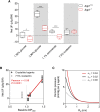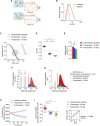Mechanisms of Crystalloid versus Colloid Osmosis across the Peritoneal Membrane
- PMID: 29844208
- PMCID: PMC6050940
- DOI: 10.1681/ASN.2017080828
Mechanisms of Crystalloid versus Colloid Osmosis across the Peritoneal Membrane
Abstract
Background Osmosis drives transcapillary ultrafiltration and water removal in patients treated with peritoneal dialysis. Crystalloid osmosis, typically induced by glucose, relies on dialysate tonicity and occurs through endothelial aquaporin-1 water channels and interendothelial clefts. In contrast, the mechanisms mediating water flow driven by colloidal agents, such as icodextrin, and combinations of osmotic agents have not been evaluated.Methods We used experimental models of peritoneal dialysis in mouse and biophysical studies combined with mathematical modeling to evaluate the mechanisms of colloid versus crystalloid osmosis across the peritoneal membrane and to investigate the pathways mediating water flow generated by the glucose polymer icodextrin.ResultsIn silico modeling and in vivo studies showed that deletion of aquaporin-1 did not influence osmotic water transport induced by icodextrin but did affect that induced by crystalloid agents. Water flow induced by icodextrin was dependent upon the presence of large, colloidal fractions, with a reflection coefficient close to unity, a low diffusion capacity, and a minimal effect on dialysate osmolality. Combining crystalloid and colloid osmotic agents in the same dialysis solution strikingly enhanced water and sodium transport across the peritoneal membrane, improving ultrafiltration efficiency over that obtained with either type of agent alone.Conclusions These data cast light on the molecular mechanisms involved in colloid versus crystalloid osmosis and characterize novel osmotic agents. Dialysis solutions combining crystalloid and colloid particles may help restore fluid balance in patients treated with peritoneal dialysis.
Keywords: aquaporin-1; membrane permeability; peritoneal dialysis; ultrafiltration.
Copyright © 2018 by the American Society of Nephrology.
Figures






References
-
- Churchill DN, Thorpe KE, Nolph KD, Keshaviah PR, Oreopoulos DG, Pagé D; The Canada-USA (CANUSA) Peritoneal Dialysis Study Group : Increased peritoneal membrane transport is associated with decreased patient and technique survival for continuous peritoneal dialysis patients. J Am Soc Nephrol 9: 1285–1292, 1998 - PubMed
-
- Brown EA, Davies SJ, Rutherford P, Meeus F, Borras M, Riegel W, et al. .; EAPOS Group : Survival of functionally anuric patients on automated peritoneal dialysis: The European APD Outcome Study. J Am Soc Nephrol 14: 2948–2957, 2003 - PubMed
-
- Davies SJ: Longitudinal relationship between solute transport and ultrafiltration capacity in peritoneal dialysis patients. Kidney Int 66: 2437–2445, 2004 - PubMed
-
- Brimble KS, Walker M, Margetts PJ, Kundhal KK, Rabbat CG: Meta-analysis: Peritoneal membrane transport, mortality, and technique failure in peritoneal dialysis. J Am Soc Nephrol 17: 2591–2598, 2006 - PubMed
Publication types
MeSH terms
Substances
LinkOut - more resources
Full Text Sources
Other Literature Sources
Molecular Biology Databases
Miscellaneous

